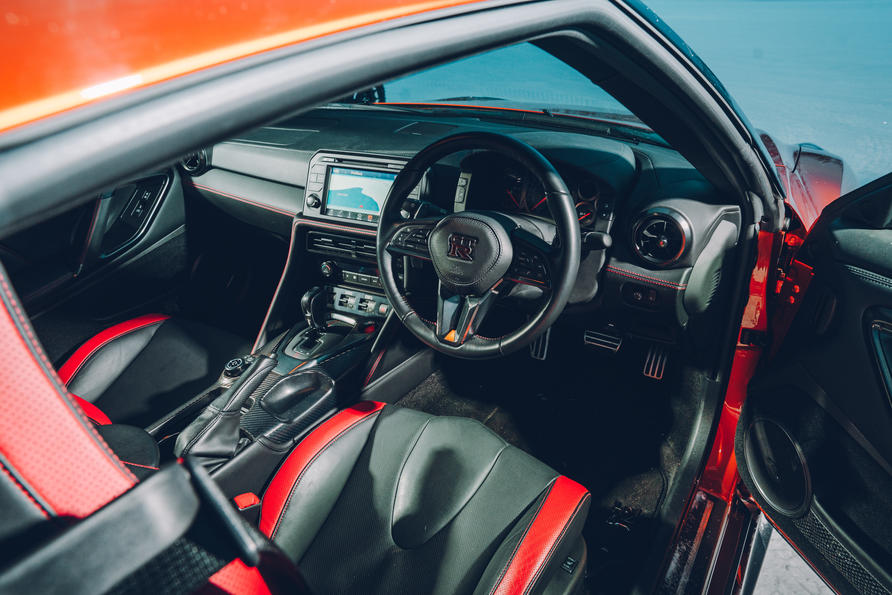
Nissan GT-R vs Honda NSX
Top Gear's Winter Games host a Japanese supercar grudge match, on ice
Stuck in a weird little intellectual eddy, I can’t stop thinking that there’s something of the Samurai about these two. Honda NSX and Nissan GT-R. Considered a bit steely and clinical by some, but devastatingly effective by all, trying to work out what psuedo-Bushido they might live by is, frankly, doing my head in.
Something about honour in simple complexity, probably. Or effectiveness over flamboyance. I think the cold is getting to me. We’re in Sweden in the death-grip of winter, it’s minus 20-degrees and my entire face has started to resemble a half-cooked chicken fillet. Time to warm up.
Words: Tom Ford/Images: Mark Riccioni/Rowan Horncastle
Housekeeping: before anyone gets rabid about comparing a £142k NSX to an £82k GT-R, I’m going to explain my reasoning. Because these two are remarkably similar in a lot of ways. Both are Japanese, heirs to iconic heritage. Both feature turbocharged V6 petrol engines with 570+bhp, both have all-wheel drive, hit 62mph in the low threes and register top speeds in the 190s.

Both weigh largely the same - the NSX being a smidge heavier, despite being a two-seater to the GT-R’s 2+2 - and both have highly sophisticated computer architectures designed to make you look like a better driver than you really are. So it feels appropriate to have a discussion about how these two compare, if at any other level than the bald stats.
While I’ve driven these two separately quite a bit, this is the first time I’ve ever driven them back to back in their ‘standard’ formats. First up, my old friend, the Nissan GT-R. Here’s a car that it has taken me a long time to fully understand, not least because of its inherent complexity. Like most Japanese performance cars, it’s preternaturally keen on acronyms, deploying 570bhp of turbo 3.8 V6 via ATTESA ET-S all-wheel drive, which stands for Advanced Total Traction Engineering System for All-terrain with Electronic Torque Split. Yeah, that.
Briefly, it’s a rear-mounted transaxle in a car with a front-mid-mounted engine, that uses a separate secondary propeller shaft doling out drive (back) to the front wheels. Might sound a bit odd - but it helps balance the GT-R’s weight distribution to 53:47 front to rear, which is useful.
What you get is a car whose power distribution has a 98 per cent rear bias under normal driving conditions, but with the capability of switching to 50:50 front-to-rear. With the rear wheels operating through a mechanical limited-slip differential, the fronts are electronically monitored via four ABS sensors, a three-axis g-sensor, and ‘box and engine ECU semi-AI to dab the brakes and mimic another diff for the front end. It ends up – once you’ve figured in the VDC-R control system – as variable torque vectoring side to side and front to back, with an even divide as to how much power can be punted where.

Inevitably, this is less complicated to drive than it is to explain. Because, when the going is slippery, the GT-R is still a monster of a thing. It might be basically the same car as the giant-killer that arrived in 2007, but it just goes to show that the basic recipe was very, very right. It’s a bit more comfortable just mooching around now, a touch more considered, but the interior is still blocky and a bit 8-bit-feeling and it still puts a smile on your face you have to remove with paint stripper.
Turn, accelerate, scythe off the opposite lock after correction and maintain an even throttle, and the GT-R simply sets in a glorious four-wheel drift, sideways with all four wheels pointing in the same direction. It feels mechanical - you can sense the diff in the back working and the steering tugging as it transfers torque - but there’s nothing particularly wrong with that. And if it’s not doing what you want, chances are, it’s your fault.
If you lose faith and back off, you remove the car’s attention and you’ll crash. Drive it like you stole it, and it comes to you. In fact, with some cars you have to be a magician to get the best out of them, be some sort of dynamic merlin to access their hidden abilities. Not this though. You can have joints of beef for hands and still get the best from it. It’s better if you’re aggressive, committed and heavily right foot-biased. It’s a gentleman thug, and I love it.
Top Gear
Newsletter
Thank you for subscribing to our newsletter. Look out for your regular round-up of news, reviews and offers in your inbox.
Get all the latest news, reviews and exclusives, direct to your inbox.
The NSX is a different kettle of hybrid, and it shows immediately. It’s not lairy enough externally to be a ‘proper’ supercar, and the interior is, let’s be honest here, a bit practical and Honda-rised to get too excited. There’s a triplet of electric motors offering instant torque assistance to the turbocharged petrol V6 (one 36bhp spool of spinny wire for each front wheel, one for the rear axle), and it finesses traction much, much better than the GT-R from the moment you step into it.
There’s 476lb ft on tap, which doesn’t sound like much, until you figure out how that torque is delivered - it feels instant, metered and full - from any engine speed. It’s very easy to drive, without the slight hunt-n-shunt you can get from the GT-R’s six-speed gearbox, and vision is pretty good for a mid-engined car - almost as good as the much more upright Nissan. On the road it also rides noticeably better than the newly comfy (but still not that comfy) GT-R.

With the traction slumbered a bit it’s very effective, but just a little removed from itself - the traction control doesn’t really seem to ever switch off properly, and there’s a blanket of anti-fun thrown over proceedings. Now, I have a natural aversion to trusting things that I can't see or touch having an effect on my physical being. It's like trying to train yourself to believe in god. Until, of course, you do something monumentally, sumptuously stupid, and feel a billion lines of code bat contemptuously at the edges of brakes, differentials and yaw sensors and yank you back from the metaphorical cliff's edge.
Or the more literal lake’s edge, depending. But when you’re trying to be silly, it’s really very frustrating. It’s not that it’s actively bad, just that all the little nipped back inputs break down into a slurry of nuance too messy to separate. Nothing is clear. Instead of the crisp clarity of the analogue-feeling, we get a fuzzy, pseudo-tactility. Both too much information, and far too little.
Until, that is, you remember how to switch everything completely off, the proper call-the-lawyer, abandon-all-hope setting. And then you realise that on a proper low-mu surface, the Honda NSX is a carefully curated veneer of ‘normal’ plastered over a bin bag full of ‘mental’. I was never quite sure what gear I was in, its nine speeds being three more than I can count, but the NSX comes alive when it forgets that it’s supposed to be a grown-up.
Again, it manages and meters torque in far more a sophisticated fashion than the GT-R, but it also feels more rear-biased, the front wheels looping in assistance only at the point where usually you’ve mentally unpacked the tow rope. Where the GT-R is foursquare, the NSX is 110-degrees to the direction of travel, and still coming back.

It’s a GT-R with mid-engined character, and has that peculiar Japanese trait of coming across as quite reserved, and then doing something entirely unexpected and really rather wild, like necking a litre of strong drink and attacking the karaoke at full volume.
As ever though, you’re building up a logjam of karmic debt that at some point is going to catch fire and burn your happy, immortal mood to the ground. You can crash these cars - it just takes a bit more effort than usual. I’d like to apologise to snapper Rowan Horncastle at this point. No reason.
Which is better? Neither. Both. They’re completely different and utterly, remarkably similar. One a four-seat, big boot, front-engined coupe, the other a two-seat, mid-engined hybrid with the carrying capacity of a trouser pocket. But they both deliver in a way that makes them almost twins.
The NSX is the GT-R’s suave older brother. Cleverer, slicker, a touch more worldly. It’s much more ‘modern’ in the way it wraps its performance, smoother and more refined. Which it should be for its additional £60k. The GT-R still has a street-fighter feel that makes it worthy of comparison. It’s a bit brutal, naughty and grand fun. Yes, the GT-R has started to feel its age and it’s not quite the giant-killing bargain it was when it was £58k back in the 2000s, but it still has enormous charm. And they both represent a uniquely Japanese way of doing things that makes them brilliant. They make us car people happy. And that’s something to celebrate.
See the rest of Top Gear magazine's Winter Games tests in the latest issue
More from Top Gear
Trending this week
- Car Review
BMW 1 Series
- Top Gear's Top 9
Nine dreadful bits of 'homeware' made by carmakers











